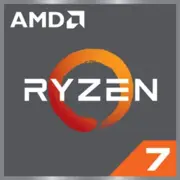AMD Ryzen 7 8840HS

AMD Ryzen 7 8840HS: A Balance of Power and Battery Life in a Slim Form Factor
The new mobile processor AMD Ryzen 7 8840HS, codenamed Hawk Point, represents an evolutionary step in the Ryzen 7000 lineup. With a focus on energy efficiency and performance in compact laptops, it promises to be the ideal solution for those who need versatility. Let's explore who this chip is suitable for, how it performs in various tasks, and what to consider when choosing a device based on it.
Architecture and Process Technology: Zen 4 and RDNA 3 in Action
The Ryzen 7 8840HS is built on the updated Zen 4 architecture, manufactured using TSMC's 4nm process. It features 8 cores and 16 threads, where each core can operate at a base frequency of 3.3 GHz and boost up to 5.1 GHz in turbo mode. Key features include:
- 16MB L3 Cache: Increased size speeds up data processing in multi-threaded scenarios (rendering, video encoding).
- Integrated Radeon 780M Graphics: Built on RDNA 3 architecture with 12 compute units. This is one of the most powerful iGPUs on the market, capable of running games at 1080p on medium settings (e.g., _Cyberpunk 2077_ — 30-40 FPS).
- Support for DDR5-5600 and LPDDR5x-7500: High memory bandwidth is critical for the performance of both the CPU and the iGPU.
Compared to the previous generation (Ryzen 7 7840HS), Hawk Point features optimized power consumption and improved Precision Boost algorithms, enhancing frequency stability under load.
Power Consumption and TDP: How AMD Fits 8 Cores into 15 Watts
The nominal TDP of the processor is 15 watts, but the chip can actually operate in the range of 15-54 Watts depending on system settings. This provides manufacturers with flexibility: in ultrabooks, the TDP is limited to enhance battery life, while in more powerful laptops, the full potential can be unleashed.
Energy-saving technologies include:
- Adaptive Power Management: Dynamically redistributes load among cores, disabling unused ones.
- Precision Boost 2: Boosts individual core frequencies without overheating.
- Manual tuning via Ryzen Master: For advanced users.
Despite the compact TDP, the laptop's cooling system must handle brief spikes up to 54 Watts—this is crucial for stable operation in turbo mode.
Performance: From Excel to Gaming
Geekbench 6 test results (2286 / 11550) place the Ryzen 7 8840HS on par with the Intel Core i7-13700H in multi-threaded tasks but with lower power consumption.
Real-world scenarios:
- Office Work: 50+ tabs in Chrome + Excel + Zoom—smooth operation with no lag.
- Multimedia: 4K video rendering in DaVinci Resolve is 30% faster than on the Ryzen 7 7735HS (Zen 3+).
- Gaming: In _Fortnite_ (1080p, medium settings)—steady 60 FPS; in _Elden Ring_ (720p, low settings)—40-45 FPS.
Turbo Mode: Under brief loads (up to 10-15 seconds), the processor can reach 5.1 GHz, but during prolonged tasks (e.g., rendering), the frequency drops to 4.2-4.5 GHz due to TDP limitations. This is sufficient for gaming, but professional designers might prefer laptops with a TDP of 35-45 Watts.
Use Scenarios: Who is the Ryzen 7 8840HS Suitable For?
1. Students and Office Workers: Lightweight laptops with 8-10 hours of battery life.
2. Freelance Creatives: Video editing, working in Photoshop on-the-go.
3. Casual Gamers: Gaming without a discrete graphics card (e.g., on the road).
4. Universal Users: Those who don’t want to own two devices—a powerful PC and a weak laptop.
Not suitable for:
- Professional streamers (too few threads for simultaneous streaming and gaming).
- Engineers working with 3D models in SolidWorks (discrete graphics needed).
Battery Life: How Long Will the Battery Last?
Under moderate load (web surfing, office tasks), a laptop with the Ryzen 7 8840HS and a 70 Wh battery can last 8-10 hours. In power-saving mode (CPU frequency limited to 2 GHz, screen at 60 Hz)—up to 12 hours.
Energy-saving technologies:
- AMD PowerNow!: Automatically reduces frequency during idle times.
- Variable Refresh Rate for iGPU: Synchronizes frame rate and screen refresh.
- Radeon Drivers' "Eco" Mode: Limits FPS in games to save battery.
Comparison with Competitors: Against Intel, Apple, and Predecessors
- Intel Core Ultra 7 155H: Comparable performance level, but the iGPU Arc lags behind Radeon 780M by 15-20%. However, Intel is better optimized for AI tasks.
- Apple M3: Higher energy efficiency (up to 18 hours of battery life in the MacBook Pro), but in multi-threaded tasks, the Ryzen 7 8840HS is 25% faster.
- Previous Generation (Ryzen 7 7840HS): Performance gain around 10-12%, but the key difference is support for new standards like Wi-Fi 7 and USB4.
Pros and Cons
Strengths:
- Best-in-class integrated graphics.
- Ideal balance between performance and battery life.
- Support for modern interfaces (USB4, PCIe 4.0).
Weaknesses:
- Under prolonged loads (rendering), it lags behind processors with a TDP of 45 Watts.
- No hardware support for AV1 encoding in the iGPU (relevant for streamers).
Recommendations for Choosing a Laptop
1. Type of Device:
- Ultrabook (e.g., ASUS Zenbook 14): Focus on battery life and portability.
- Hybrid Laptop-Tablet (Lenovo Yoga 7): For creative tasks with a touchscreen.
- Compact Workstation (HP Envy 16): With cooling for prolonged loads.
2. What to Pay Attention To:
- Cooling System: At least two fans and heat pipes.
- Display: 90+ Hz and 100% sRGB for gaming and design.
- Battery: From 70 Wh.
Conclusion
The AMD Ryzen 7 8840HS is a processor for those seeking the "golden mean." It is suitable for:
- Users who value mobility but do not want to sacrifice performance.
- Gamers playing less demanding titles without a discrete graphics card.
- Freelancers working in "field conditions."
Key advantages include the Radeon 780M, support for the latest standards, and flexibility in TDP settings. If you're looking for a versatile laptop without compromises, the Hawk Point is an excellent choice.
Basic
CPU Specifications
Memory Specifications
GPU Specifications
Miscellaneous
Benchmarks
Compared to Other CPU
Related CPU Comparisons
Share in social media
Or Link To Us
<a href="https://cputronic.com/cpu/amd-ryzen-7-8840hs" target="_blank">AMD Ryzen 7 8840HS</a>

